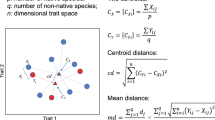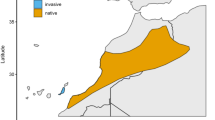Abstract
Knowledge of characteristics helpful in screening potential invaders and in elaborating strategies to limit their success is highly desirable. We focused on gammarid amphipods from Western Europe and North America to discover biological and/or ecological traits that may explain successful invasion by these species. Two typologies were considered: an analytical one, with groups built on the basis of biological or ecological similarities, and an empirical one, with groups constituted a priori according to a species’ invasive status and its fresh or brackish water origin. The results obtained are discussed in the light of three hypotheses that may influence invasiveness: biotic potential, species size and euryoeciousness. The analysis revealed a particular ecological profile for invaders, with a strong influence of salinity tolerance, but no typology was found based on biological characteristics. Invasiveness cannot be predicted from a limited number of criteria, and is the result of a combination of several characteristics. Invasive species therefore exhibit a particular ecological profile rather than a biological one, contrary to most classical explanations.
Similar content being viewed by others
References
Barnard JL, Barnard CM (1983) Freshwater Amphipoda of the world (2 volumes). Virginia, Hayfield Associates
Bazzaz FA (1986) Life history of colonizing plants: some demographic, genetic, and physiological features. In: Mooney HA, Drake JA (eds), Ecology of Biological Invasions of North America and Hawai. Springer-Verlag, Berlin, pp. 96–110
bij de Vaate A, Jazdzewski K, Ketelaars HAM, Gollasch S, Van der Velde G (2002) Geographical patterns in range extension of Ponto-Caspian macroinvertebrates species in Europe. Canadian Journal of Fisheries and Aquatic Sciences 59:1159–1174
Cassey P (2001) Are the body size implications for the success of globally introduced land birds?. Ecography 24:413–420
Chevenet F, Dolédec C, Chessel D (1994) A fuzzy coding approach for the analysis of long-term ecological data. Freshwater Biology 31:295–309
Colautti RI, MacIsaac HJ (2004). A neutral terminology to define ‘invasive’ species. Diversity and Distribution 10:135–141
Dick JTA, Elwood RW (1993) The mating system of Gammarus pulex: a negligible role for micro-habitat segregation. Animal Behaviour 45:188–190
Devin S, Bollache L, Noël PY, Beisel JN (2005) Patterns of biological invasions in French freshwater systems by non-indigenous macroinvertebrates. Hydrobiologia 551:137–146
Duncan RP, Bomford M, Forsyth DM, Conibear L (2001) High predictability in introduction outcomes and the geographical range size of introduced Australian birds: a role for climate. Journal of Animal Ecology 70:621–632
Hayes KR, Sliwa C (2003): Identifying potential marine pests – a deductive approach applied to Australia. Marine Pollution Bulletin 46:91–9
Hynes HBN (1954) The ecology of Gammarus duebeni Lilljeborg and its occurence in fresh water in Western Britain. Journal of Animal Ecology 23:38–84
Illies J (1978) Limnofauna Europaea. Fischer Verlag, Stuttgart
Ketelaars HA (2004) Range extension of Ponto-Caspian aquatic invertebrates in continental Europe. In: Dumont H, Shiganova TA, Niermann U (eds), Aquatic Invasions in the Black, Caspian and Mediterranean Seas. NATO Science Series, Kluwer, Dordrecht, pp. 209–236
Kolar CS, Lodge DM (2001) Progress in invasion biology: predicting invaders. Trends in Ecology and Evolution 16:199–204
Lee CE, Bell MA (1999) Causes and consequences of recent freshwater invasions by saltwater animals. Trends in Ecology and Evolution 14:284–288
Leppäkoski E, Gollasch S, Gruszka P, Ojaveer H, Olenin S, Panov V (2002) The Baltic – a sea of invaders. Canadian Journal of Fisheries and Aquatic Sciences 59:1175–1188
Leppäkoski E (2004) Living in a sea of exotics – the Baltic case. In: Dumont H, Shiganova TA, Niermann U (eds), Aquatic Invasions in the Black, Caspian and Mediterranean Seas. NATO Science Series, Kluwer, Dordrecht, pp. 237–255
Lloret F, Médail F, Brundu G, Camarda I, Moragues E, Rita J, Lambdon P, Hulme PE (2005) Species attributes and invasion success by alien plants on Mediterranean islands. Journal of Ecology 93:512–520
Lodge DM (1993) Biological invasions: lessons for ecology. Trends in Ecology and Evolution 8:133–137
MacIsaac HJ, Grigorovich IA, Ricciardi A (2001) Reassessment of species invasions concept: the Great Lakes basin as a model. Biological Invasions 3:405–416
Miller AW, Hewitt CL, Ruiz GM (2002) Invasion success: does size really matter? Ecology Letters 5:159–162
Peters RH (1983) The Ecological Implications of Body Size. Cambridge University Press, Cambridge
Piscart C, Moreteau J-C, Beisel J-N (2005) Biodiversity and structure of macroinvertebrate communities along a small permanent salinity gradient (Meurthe River, France). Hydrobiologia 551:227–236
Ricciardi A, Rasmussen JB (1998). Predicting the identity and impact of future biological invaders: a priority for aquatic resource management. Canadian Journal of Fisheries and Aquatic Sciences 55:1759–1765
Roy K, Jablonski D, Valentine JW (2002) Body size and invasion success in marine bivalves. Ecology Letters 5:163–167
Sainte-Marie B (1991) A review of the reproductive bionomics of aquatic gammaridean amphipods: variation of life history traits with latitude, depth, salinity and superfamily. Hydrobiologia 223:189–227
Shiganova TA, Dumont HJ, Sokolsky AF, Kamakin AM, Tinenkova D, Kurasheva EK (2004) Population dynamics of Mnemiopsis leidyi in the Caspian Sea, and effects on the Caspian ecosystem. In: Dumont H, Shiganova TA, Niermann U (eds), Aquatic Invasions in the Black, Caspian and Mediterranean Seas. NATO Science Series, Kluwer, Dordrecht, pp. 71–111
StatSoft Inc. (2004) STATISTICA (data analysis software system), version 7. www.statsoft.com
Statzner B (1987). Characteristics of lotic ecosystems and consequences for future research directions In: Schulze ED, Zwölfer H (eds), Potentials and Limitations of Ecosystem Analysis. Springer-Verlag, Berlin, pp. 365–390
Thioulouse J, Chessel D, Dolédec S, Olivier JM (1997) ADE-4: a multivariate analysis and graphical display software. Statistics and Computing 7:75–83
Van der Velde G, Rajagopal S, Kelleher B, Muskó IB, Bij de Vaate A. (2000). Ecological impacts of crustacean invaders: General considerations and examples from the river Rhine. Crustacean Issues 12:3–33
Vasquez DP, Simberloff D (2001) Taxonomic selectivity in surviving introduced insects in the United States In: Lockwood JM, McKinney ML (eds), Biotic Homogenization. Kluwer Academic/Plenum Publishers, New-York, pp. 103–124
Vermeij GJ (1996) An agenda for invasion biology. Biological Conservation 78:3–9
Williamson M (1996) Biological Invasions. Chapman & Hall, London
Acknowledgments
We thank Maïa Akopian for help in collecting data, Philippe Usseglio-Polatera and Chad Hewitt for helpful comments on the manuscript and Anna Cartier for linguistic corrections. This study was supported by the ‘Ministère de l’Ecologie et du Développement Durable,’ as part of the INVABIO – Biological Invasions 2003-2005 program.
Author information
Authors and Affiliations
Corresponding author
Rights and permissions
About this article
Cite this article
Devin, S., Beisel, JN. Biological and ecological characteristics of invasive species: a gammarid study. Biol Invasions 9, 13–24 (2007). https://doi.org/10.1007/s10530-006-9001-0
Received:
Accepted:
Published:
Issue Date:
DOI: https://doi.org/10.1007/s10530-006-9001-0




